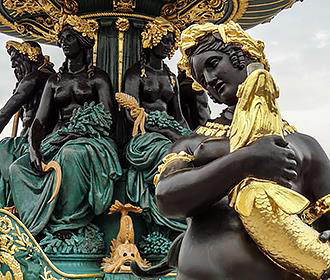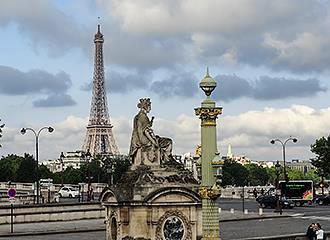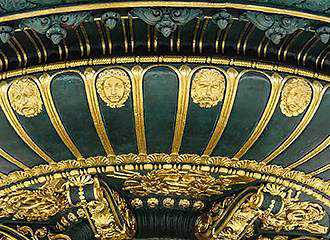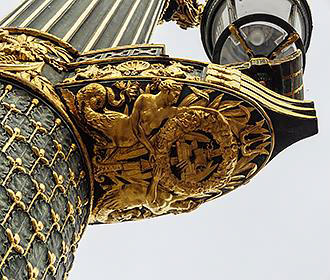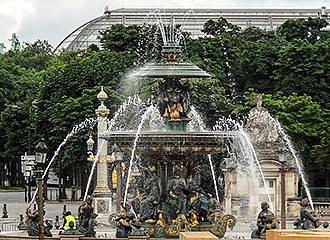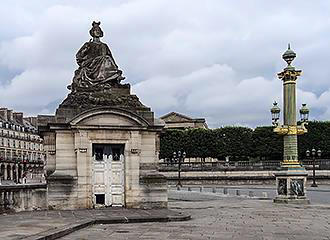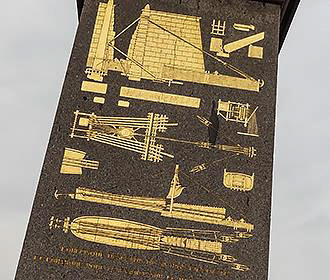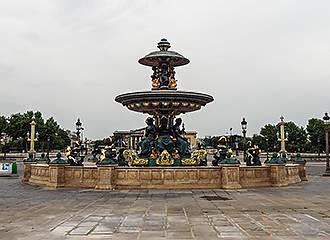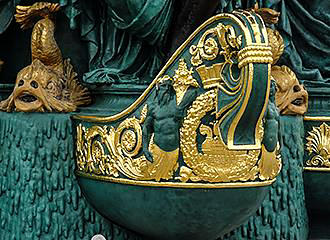Paris Place de la Concorde Square
The Place de la Concorde is the largest square in Paris that is located along the River Seine between the Tuileries gardens and the Champs Elysees Avenue, and this square has its own rich history, but it also has the oldest monument in Paris located in the centre called the Luxor Obelisk.
The beginnings of Paris Place de la Concorde Square
Originally there was an equestrian statue that was commissioned by the City of Paris in 1748, which was designed by the sculptor Edme Bouchardon, and you can get to see one of his works called the Fontaine des Quatre-Saisons at the Rue Grenelle in Paris.
Now this equestrian statue was designed to be of King Louis XV on a horse to commemorate the victory of France in the war of Austrian Succession, but it was only actually put in place after the defeat of France in the Seven Years War.
The square itself was designed by the architect Ange-Jacques Gabriel who was the chief architect to the King of France, and work started on the square in 1754, which was to be called the Place Louis XV.
It was actually designed as an octagon shape with the focal point being the equestrian statue that was to be flanked by two fountains, yet due to lack of water available at the time the fountains were never put in place and the square was not actually completed until 1763, plus it originally had moats bordering it, but these are no longer in existence.
The French Revolution and Place de la Concorde Square
It was during the French Revolution that the original equestrian statue of King Louis XV was destroyed and another called Liberte, or Freedom, was erected in the square, which then became known as the Place de la Revolution.
Unfortunately, it was during this horrific time in the history of Paris that the Place de la Concorde square has become so well known, as a guillotine was erected in the centre of the square in 1792 and for around two years thousands of people that had been detained at La Conciergerie came to their deaths.
Some of the most famous people beheaded at the Place de la Concorde square were those of King Louis XVI and his wife Marie Antoinette and the bodies were transported to a cemetery site in another part of Paris. In fact, years later King Louis XVIII had a chapel constructed at the site of the cemetery in memory of these two monarchs and others sentenced to death, and called the Chapelle Expiatoire which you can still visit this today.
Another major figure that was eventually beheaded was Maximilien Robespierre, who was the main instigator in the Reign of Terror during the French Revolution and fortunately it was after his demise that the revolution subsided and things started to returned to normal.
And in between the Place Louis XV and the Champs Elysees Avenue there were already the marble sculptures called the Horses of Marly that had been moved from the Chateau de Marly to Paris, which is rather fortunate considering the Chateau de Marly was also destroyed during the French Revolution.
Improvements and redesign of Place de la Concorde Square
After the French Revolution, in 1795 a painter called David instructed that the statues by the sculptor Coustou be put in place between the Paris Place de la Concorde square and the Champs Elysees Avenue, which made a great impact, yet the square also changed its name several times.
The guillotine had of course already been removed from the square, as was the statue that had been erected during the French Revolution, so as to try and forget about the bloodshed and attrococities that had taken place, and the Paris monarchy, people and government wanted the square to become recognised for people and foreign relations.
And so, after the devastation and turmoil that had taken place, in 1830 the square was given the name of Place de la Concorde, which is what it is still known as today, and it was Jacques Ignace Hittorff who redesigned the square and his designs were implemented from 1833 through to 1846.
The statues at Paris Place de la Concorde Square
There were eight different statues that were designed by Jacques Hittorff placed at each corner of the Place de la Concorde square, which were there to represent the major French cities in France.
The statue for Bordeaux in the Aquitaine region and the one for the city of Nantes were sculpted by Louis-Denis Caillouette, the statue representing Brest in the Brittany region along with the one for the city of Rouen, were sculpted by Jean-Pierre Cortot and the statue for Marseille in the Alpes Cote d’Azur region, along with the one for the city of Lyon were produced by Louis Petitot.
The statues representing the cities of Lille and Strasbourg were produced by Jean-Jacques Pradier who was a friend of Victor Hugo. But after the Franco-Prussian War of 1870 when both the Lorraine region and Alsace were lost to Germany, the Strasbourg statue, which is the capital city of the Alsace region, used to be covered in a black mourning cape on specific occasions along with wreaths placed there, and this continued right up until France regained the region after World War I.
Anyway, getting back to the progress of the Paris Place de la Concorde square, it was during the reign of King Louis Philippe after the July Revolution of 1830 that a monolith that was over 3000 years old called the Luxor Obelisk, was provided as a gift from the Egyptian Viceroy Mehmet Ali Pesha.
This was to be put in place in the middle of the Place de la Concorde square and the pink granite Luxor Obelisk that is decorated with hieroglyphics was installed on a pedestal in 1936 that portrays the mammoth task of getting the oldest Paris monument back to France and erected in its current position.
We also quickly mentioned earlier on about the Horses of Marly that were the monumental statues produced by Guillaume Coustou, that are located at the start of the Champs Elysees Avenue. Well, the original statues are now being preserved at the Musee du Louvre to protect them even further from the elements, but exact replicas of these have been put in place in the same location at one point of the Place de la Concorde square.
The fountains of Place de la Concorde Square
Because the Canal de l’Ourcq had been completed, this meant that there would be sufficient water in which to place fountains in the square, as per the original idea, and so, at the same time as the square was being reconstructed the Luxor Obelisk monument was being put in place, along with the two fountains designed by Jacques Ignace Hittorff.
These were on the theme of rivers and seas, which is probably because the River Seine is close by and the Naval Ministry also had its headquarters in a building located at one end of the square, plus these were also based on designs from twin fountains from Rome.
The first of these fountains was called La Fontaine des Mers, which is a bronze fountain added to the square on one side of the Luxor Obelisk. The second fountain was then added in 1839, and is in complete alignment with the first and designed in exactly the same way.
There were actually twelve different sculptors who worked on the fountains and the one on the south side of the Place de la Concorde square is closest to the River Seine and represents the Maritime spirit of France like the Atlantic Ocean and the Mediterranean Sea along with fish, shells, coral, etc. The other on the north side represents rivers like the River Rhone and the River Rhine along with harvest commerce such as grapes for wine and fruit, etc.
The fountains were originally gravity fed from the Canal de l’Ourcq, because the water arrived in to Paris from this source, which was higher than the Place de la Concorde square and any extra ran into the River Seine. However, many years later these were eventually modified, so in the 20th century when pumps were added these fountains stop being gravity fed so that the water could be recycled.
Discovering more at Paris Place de la Concorde Square
Located in the 8th Arrondissement of Paris, the Place de la Concorde square is the largest square in Paris that separates the famous Champs Elysees Avenue and Tuileries Gardens of the Musee du Louvre, which is of course the most impressive and well known of all Paris museums, if not the world.
At the north end of the Place de la Concorde square you will find two magnificent buildings that were erected, and even today, they are fine examples of architecture from this period in the history of Paris and it was the eastern building that was home to the French Naval Ministry.
The western building was owned by the Crillon family and eventually was turned into the Hotel de Crillon, which is still one of the plush hotels in Paris that you can enjoy today, yet it was also occupied by the German army during World War II.
Bar the actual ground, which is now made of concrete and tarmac, the Paris Place de la Concorde Square is very similar to the original designs and those of the improvements made after the French Revolution.
This Paris square also marks an intersection of two axis, and the minor one forms a line between the Place de la Madeleine and Madeleine Church down the Rue Royale across the Pont de la Concorde bridge to the Palais Bourbon on the Left Bank of the River Seine.
The second or major axis is known as the Voie Triumphale, which translates to Triumphal way and this extends from an east to west direction that starts from the original Palais du Louvre prior it becoming a museum.
This axis then goes past the Arc de Triomphe du Carrousel that was commissioned by Napoleon Bonaparte I, continues through the Tuileries Gardens, across the Place de la Concorde square and onto the Champs Elysees. It continues again to the famous Paris landmark the large triumphal arch called the Arc de Triomphe, which is also home to the Tomb of the Unknown Soldier and the eternal Flame. In more recent times, this axis now continues beyond this point right through to the Grande Arche in the Defense area of Paris.
So when you are on holiday in Paris, this is well worth a visit, plus it is an ideal meeting place, or one to branch out from to enjoy many other aspects of Paris, like the River Seine, museums such as the Jeu de Paume and the L’Orangerie along with the Louvre and much more.
Yet you can also experience some fabulous different views from the Place de la Concorde square such as the Eiffel Tower in the distance in one direction, the Arc de Triomphe in another, not forgetting how the square feels completely different at night, with the fountains shimmering against the lights.
Visiting Paris Place de la Concorde Square
When it comes to reaching the Paris Place de la Concorde square via public transport, you will find that the nearest Metro station is called the Concorde stop serving Lines 1, 8 and 12.
However, walking in a northerly direction you can get to the Madeleine stop that serves lines 8, 12 and 14, yet in a westerly direction walking up the famous Avenue des Champs Elysees you have the Champs-Elysees - Clemenceau stop serving Lines 1 and 13.
There are also several Paris bus lines that will get you close by to this square including 24, 42, 72, 73, 84, 94 along with the Noctilien Night Bus Service via lines N11 and N24, yet the nearest RER train station is the Invalides stop on the opposite bank of the River Seine, which serves the RER C Line.
